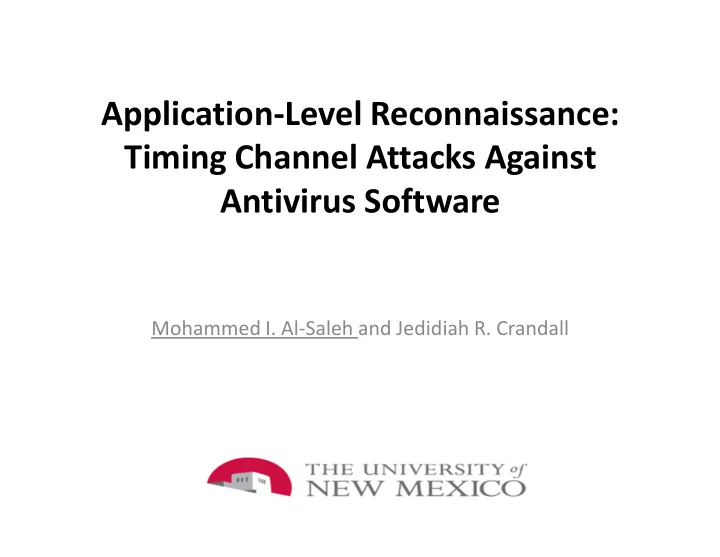

Application-Level Reconnaissance: Timing Channel Attacks Against Antivirus Software Mohammed I. Al-Saleh and Jedidiah R. Crandall
Server Reconnaissance OS & Services ports Client Server
Client Reconnaissance Hmmm, what can I get about you?!! Client Server
Client Reconnaissance • Browser identification – https://panopticlick.eff.org/ • AV related info – AV fingerprinting – Up-to-date? • Timing channels – AV performance tradeoff – Make the common case fast – Updated?
Threat Model Measure scanning time Updated?? Client Server
Basic Idea • Antivirus (AV) scans data against sigs • Sigs are stored somehow in AV’s data structures • Scanning time – Based on scanning path • Hitting the newly added sigs
ClamAV • ClamAV – http://www.clamav.net – http://www.clamxav.com/ – http://www.clamwin.com/ • Scanning steps: – File type filtering – Filtering step – Boyer-Moore algorithm – Aho-Corasick algorithm
File Type Filtering File to scan Type Roots File Type Filtering Type
Filtering Step Input Yes/No Filter
Boyer-Moore Sig Array of LLs chars HASH Sig
Aho-Corasick
Methodology • Question #1 : Is there a timing channel in the way ClamAV scans data? • Question #2 : If the first question is confirmed, how could the attacker create the timing channel?
Methodology/Q1 • Collect viruses in (name,date) pairs and remove their sigs from current DB
Two Kinds of Experiments • Whole-day sig experiment • Single sig experiment
Whole-Day Sigs of DateX Becomes DB before DateX DB after DateX Old New Scan
content BuffSize = 256 KB ( ( (ahochars|boyerchars)^n . filterchars)^m) File Size
Single Signature One Sig Becomes DB before SigX DB after SigX Old New Scan
Whole-Day Frequency Time Difference (seconds) )
Single Frequency Time Difference (seconds) )
Methodology/Q2
Methodology/Q2 Time Start CPU Time Determine CPU Create file Close the file Busy Time Sampling
Scanning Time (seconds) Min ActiveX Max
Possible Timing Channels in Modern AVs • Pattern matching • Algorithmic scanning – Zmist virus needs to execute at least 2 million p- code-based iterations • Code emulation – Significantly slows scanning • Heuristics – Extra work when triggered
Related Work • Network discovery – Port scanning • Timing channel attacks – Secret keys in cryptographic systems – Virtual machines detection – Others • Antivirus research – Signature extraction – Detection evasion
Conclusion and Future Work • Application-level reconnaissance through timing channels • Running example: ClamAV • Currently, we are exploring performance issues in commercial antiviruses
Acknowledgements • Török Edwin • LEET reviewers • U.S. National Science Foundation (CNS- 0905177)
Thanks
Recommend
More recommend